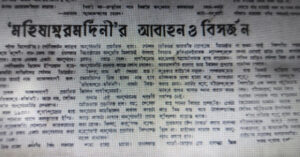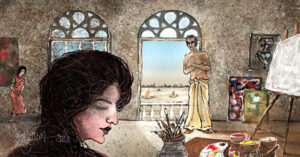We are all living through desperate and difficult times — through a disease that has wiped out millions of people, through deep economic crises, and a war that does not show signs of ending soon. Add to all that misery, the many times that death has come knocking at the doors of artistes in the last few months. On the 31st of May, 2022, it swooped down on Krishnakumar Kunnath, the highly accomplished and popular singer known as KK, soon after he performed to a crowd of fans in Kolkata. KK’s sudden, premature and shocking demise was widely mourned, covered by the press and media, discussed, debated and even politicised. What no one bothered to discuss were the many demanding, potentially dangerous and risk-ridden situations in which artistes in India continue to perform. This collective indifference raises the question of whether we truly care for our artistes and whether or not we are all accountable in one way or the other, for such tragic instances and losses. Some of what I write may be interpreted as being callous or cruel, but truth and fact are often stark and in your face. Nothing, not kind words, humming and hawing, or attempts at being tactful can change facts.
Over several decades of a performing career, I have been in many such situations myself. I quote from my own experiences to draw attention to some unfortunate facts. Events that draw large crowds and attract thousands of listeners are often held in open spaces, which means that they are also more susceptible to the vagaries of climate and nature. I recall arriving in a city in northern India for one such event several years ago. A turbulent flight and landing heralded stormy, rainy weather, and it became amply clear from the time we disembarked that there would be heavy rainfall. But representatives of the organisers cheerfully informed us that the event would continue as planned on an open-air stage to accommodate large crowds and also because a fancy set had been specially designed for the event. So we gamely arrived at the venue that evening and parked ourselves in the temporary green room facility that had been constructed for participating artistes. Within a few minutes, the skies burst open and let forth torrential rain. Soon, the green room — which was basically a large tent/pandal like structure behind the stage — was dripping, and the ground squelching as we moved. We heard that the Odissi dancers on stage had been asked to quickly close their recital, but even as they hurriedly tried to end graciously rather than abruptly, one of them slipped on the wet stage and injured herself. Meanwhile, we waited in the green room, quite certain that the performance would have to be called off or postponed. We hoped in vain, because the weather had decided to have some fun with us. Over the next half-an-hour or so, the rain would repeatedly slow down to a drizzle, sending the organisers scampering to start the performances again. But just as we made our way towards the stage, it would pelt down again, sending us scurrying back to the green room. Very soon, our audio engineer and the stage and sound team at the event declared that it would be unsafe to plug in any electronic equipment with so much rain, and with so many cables and wires criss-crossing the stage and ground. But the organisers would not accept defeat, because important politicians, bureaucrats and officials had arrived in the interim and were waiting in their vehicles for the rainfall to abate. Finally, I was asked to perform alone on a minus-one track, on a stage that was dripping wet. I refused to do so, but there was a lot of pressure to sing at least one composition, if not more, because the VIPs would be disappointed if they were to return without witnessing at least a truncated performance. Ultimately, I performed with a man stationed behind me holding a beach umbrella over my head valiantly as the rain pelted down on us mercilessly.
My audience, consisting of the Chief Minister of a state with another beach umbrella-bearer behind him, several important officials getting a soaking in the rain, and hundreds of music lovers who picked up the red plastic chairs they were meant to be seated on and used them as four-horned rain covers over their heads, merrily listened to Ab Ke Sawan and Dholna, which I delivered to my surreal audience of red-horned reindeer. There was applause, merry-making, but either me or my umbrella-bearer, or both of us, could easily have been electrocuted.
My audience, consisting of the Chief Minister of a state with another beach umbrella-bearer behind him, several important officials getting a soaking in the rain, and hundreds of music lovers who picked up the red plastic chairs they were meant to be seated on and used them as four-horned rain covers over their heads, merrily listened to Ab Ke Sawan and Dholna, which I delivered to my surreal audience of red-horned reindeer. There was applause, merry-making, but either me or my umbrella-bearer, or both of us, could easily have been electrocuted. The audio engineer who valiantly handled sound for us also faced the same danger, and there could have been any number of injuries among audience members too. I have lived to tell the tale, but it could have all gone horribly wrong too. In this particular instance, the most powerful officials in the state were present, but did not think fit to call off the event. Neither did I stick to my ground and refuse to cooperate. Each one of us therefore participated willingly or at best hesitatingly in a potentially dangerous situation.
There are umpteen other unsafe situations that artistes perform through. Badly constructed stages which could collapse with the weight of a single person, leave alone an entire ensemble of artistes; crowded venues with hordes of unruly admirers surging up on stage to meet their favourite artistes; no security arrangements before, after or during performances —all create potentially hazardous situations that artistes perform through and survive, if they are fortunate. And if anyone believes that these situations only arise in events featuring popular music, they would be proved wrong. At one of the country’s oldest festivals of classical music, music lovers entered the green room after my performance seeking autographs. As I sat down on a chair to sign autographs, people milled around pushing and jostling each other till they almost collapsed in a heap over me. I had to be rescued by attending police constables, and emerged from the heap of humanity gasping for breath, red in the face from the lack of oxygen.
Clearly, crowd control, stage and sound arrangements are not aspects that artistes have any control over. What they do have control over is the right to say whether or not they are willing to continue performing in often unhygienic, unsafe situations. Whether they choose to exercise that right or not, is a matter of personal choice. But until these facts are accepted, one cannot even hope for change. And every now and again, tragedy will strike, in one way or the other.
Illustration by Anustup Sen





